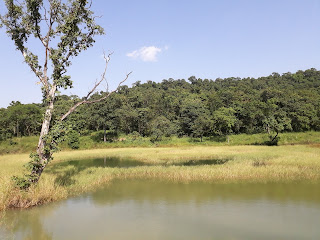Situated on the borders of Madhya Pradesh and Chhatisgarh , Amarkantak is a hill-station 164 Km (via Katghora , Pendra and Keonchi) from NTPC-Korba , 121 Km from Bilaspur(via Kota) and 135 Km from Bilaspur (via Ratanpur, Marwahi Bypass road) . The hills , thick forests and cool climate of Amarkantak allures a traveler to revisit the place.
Amarkantak is also a place of religious importance and the source of two important Indian rivers, namely the Narmada and the Son rivers.
Our latest visit to Amarkantak was in Oct2018 and our route was via Katghora , Pendra and Keonchi . We reached Amarkantak in the evening. In October , the evenings in Amarkantak are pleasantly cool . After checking into our rooms , we visited the Narmada temple which was a walking distance from our lodge . After the temple visit , we had our dinner and retired for the day.
The next morning we woke up early and headed to the Sonmuda point to see the sunrise , but alas , we were late and the Sun was already up in the sky. Nevertheless , the views from Sonmuda point are always magnificent and impress the tourist. The pleasant cool and fresh morning breeze makes the Sonmuda visit a memorable one.
Notes : 1. Beware of the monkeys here, they snatch your eatables.
2. The local restaurants here are over-priced and serve poor food.
 |
| Sunrise from Sonmuda point |
 |
| The forests waking up in morning sunlight |
 |
| Eastern view from Sonmuda point |
 |
| Northern view from Sonmuda point |
 |
| The vast expanse of nature seen from Sonmuda point |
While returning from Sonmuda point , we visited the Sri Yantra temple. At our lodge we quickly refreshed ourselves and started our tour of Amarkantak.
 |
| Sri Yantra Temple |
 |
| Sri Yantra Temple |
 |
| Sri Yantra Temple |
 |
| Sri Yantra Temple , Interiors |
 |
| Narmada Temple |
 |
Lotus lake near Narmada temple
|
We visited the ancient group of monuments which are a group of ancient temples maintained by Archeaological Survey of India (ASI) . These group of temples are adjacent to the Narmada temple . Presently (as of Oct2018) there is no entry fee to this site .The temple complex consists of five temples beautifully constructed in stone-masonry . Gardens , landscaping and fountains maintained by ASI is commendable. The Karna temple and the surrounding lawns are good for family sitting.
Note : Here vehicle (4-wheeler) parking charges is Rs.50/-
 |
| Ancient group of monuments |
 |
| Ancient group of monuments |
 |
| Shiv Mandir , Ancient group of monuments |
 |
| Ancient group of monuments |
 |
| Good place for family sitting |

 |
| Karna temple, Ancient group of monuments |
The next we went to see he nature view point on the Rajendragram road . It is a small view point about 3-4 Km from Amarkantak Bus stand . The view point is adjacent to the main road , overlooking the green valley and hills. In mid-October this road is bordered with beautiful wild flowers . We spent some peaceful time over here.
 |
| Nature view point along SH4 , Rajendragram road |
 |
| Natureview point , Rajendragram road. |
 |
Jain temple (under construction)
 |
| Interiors of Jain temple |
|
We then visited a restaurant on the main road in Amarkantak .We had a sumptuous breakfast and then headed to Kapildhara waterfalls. This water fall is about 4-5 Km from the main Amarkantak town. Here vehicle parking charges here is Rs.50/-
From the parking area, one has to walk to Kapildhara falls for about 600m on a kuccha road.Vehicles can be taken upto Kapildhara waterfall at an additional parking charge . A view point is available near the Kapildhara falls from where we get a superb view of the falls .One can reach the bottom of the falls by walking a steep descending track passing through thick woods .The track is initially in the form of stairs which subsequently becomes a mud track. On the way, eatables and lemon-water stalls are available . Kapildhara waterfall has a height of about 12m and crowded with tourists.
Further descending the same track for about 15 min. will lead to Dudh dhara waterfall. The waters of Kapildhara falls further becomes Dudh dhara waterfalls.
 |
| Kapildhara waterfall top view |
 |
| Kapildhara waterfall view point |
 |
| Kapildhara waterfall (at the base) |
 |
| Dudhdhara waterfall |
Dudh dhara waterfalls has a height of about 2m and the pool at its base is suitable for swimming. It is a favourite place for picnickers and campers. One can enjoy a good deal of time over here.
 |
| Jungle herbs on sale (on way to Kapildhara) |
 |
| The road from Amarkantak to Keonchi |
From Kapildhara we headed to NTPC-Korba via Keonchi -Pendra .
For accommodation, Bhakt Niwas lodge is OK . For food , Basant bhojanalay offers good food at reasonable rates. Both places are situated in the Amarkantak main town , near Narmada temple.
 |
| Amarkantak Schematic Map (not to scale) |







































































